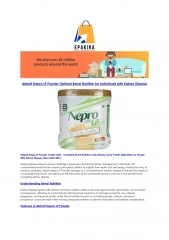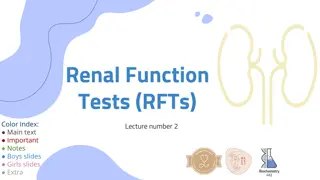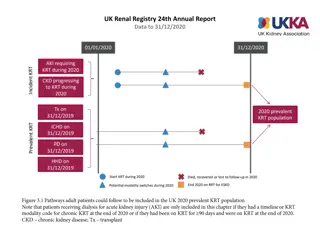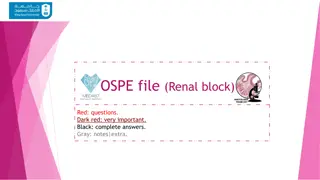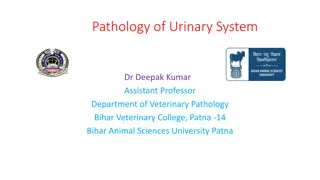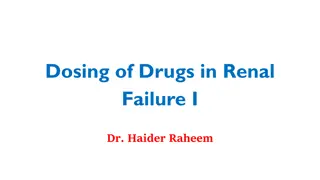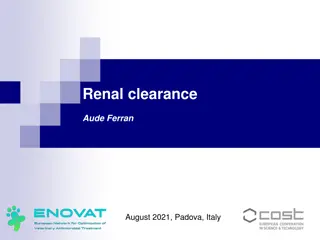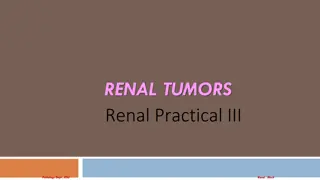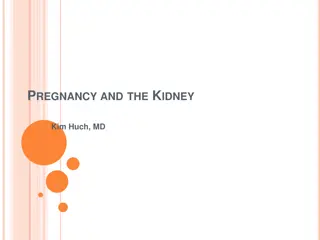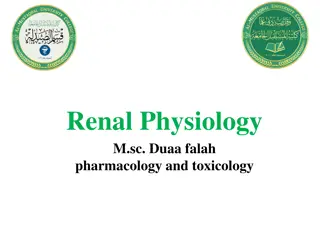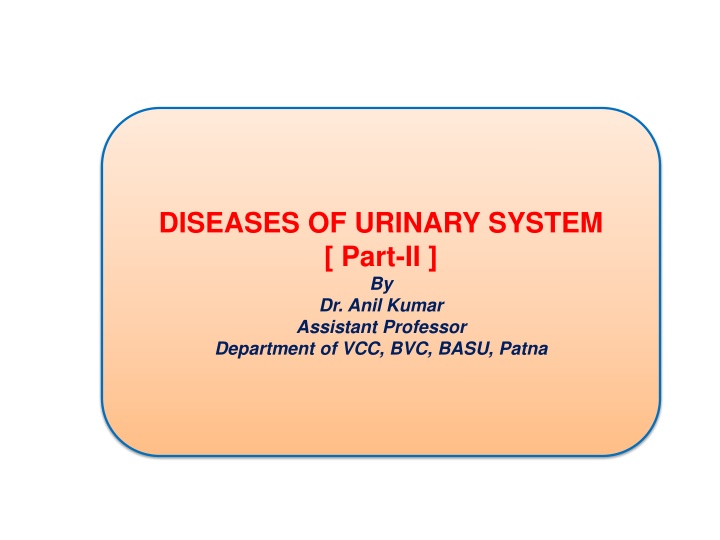
Acute Kidney Injury: Causes and Pathophysiology
Explore the causes and pathophysiology of acute kidney injury (AKI), a condition characterized by a rapid decline in kidney function due to factors like ischemia, nephrotoxins, and infections. Learn about the mechanisms behind AKI and how it impacts the body's ability to maintain fluid and electrolyte balance. Discover the importance of recognizing and managing AKI in veterinary and medical settings to prevent further kidney damage.
Download Presentation

Please find below an Image/Link to download the presentation.
The content on the website is provided AS IS for your information and personal use only. It may not be sold, licensed, or shared on other websites without obtaining consent from the author. If you encounter any issues during the download, it is possible that the publisher has removed the file from their server.
You are allowed to download the files provided on this website for personal or commercial use, subject to the condition that they are used lawfully. All files are the property of their respective owners.
The content on the website is provided AS IS for your information and personal use only. It may not be sold, licensed, or shared on other websites without obtaining consent from the author.
E N D
Presentation Transcript
DISEASES OF URINARY SYSTEM [ Part-II ] By Dr. Anil Kumar Assistant Professor Department of VCC, BVC, BASU, Patna
ACUTE KIDNEY INJURY A rapidly progressive impairment in the kidney s ability to filter metabolic waste, as well as maintain the body s fluid and electrolyte balance Etiology: Ischemia, nephrotoxins, infectious agents, or systemic disease In companion animal medicine, AKI is most commonly the result of exposure to toxins and infectious agents.
Table-1 Common causes of acute kidney injury(AKI)
Pathophysiology: Many specific mechanisms depending upon the cause Example: NSAIDs Block the cyclo-oxygenase pathway preventing the formation of locally protective prostaglandins in the kidney. Activation of the renin angiotensin system leads to vasoconstriction in the glomerular capillary bed. As the arterioles constrict, blood flow out of the glomerulus and into peritubular capillaries decreases. If left as such, the resulting decreased blood flow to the medulla of the kidney leads to ischemic injury. Suppression of the renin angiotensin system by IV fluid therapy can help prevent this vasoconstriction
An insult to the kidney is dependent on a combination of 4 features: Injury decreases glomerular permeability (Figure 1) and causes vasoconstriction (Figure 2). This leads to decrease GFR and ultrafiltrate production. Fig-1 Filtration of the blood significantly decreases. Fig.-2
As a result of the injury, dead epithelial cells, cellular debris, and proteins are discarded into the tubular lumen and form obstructive casts Lastly, swelling and inflammation of the damaged renal parenchyma externally compresses renal tubules. These obstructive hydrostatic pressure capsule and block glomerular filtration. Due to death of tubular epithelial cells there in no barrier to prevent diffusion electrolytes and fluids (Fig.-4). Thus, up to 50% of glomerular filtrate can be lost to backleak , and urea, creatinine, electrolytes, and glomerular filtration fail to be excreted. forces within increase Bowman s Fig.3-Tubular obstruction fluids undergoing Fig.4-Back leak
Toxic and ischemic insults Intrarenal vasoconstriction Decreases blood flow delivered to the glomerulus Decrease in GFR Resulting hypoxia in the PCT and ascending loop of Henle. Due to high Metabolic activity and limited blood supply(PCT & Ascending loop Further permanent nephron loss.
Clinical presentation: Depends on the underlying cause, severity of the azotemia, and electrolyteimbalances Depression, weakness, dehydration, anorexia, vomiting, diarrhea, uremic breath, oral ulcers and hypothermia Diagnosis: History(exposure to environmental nephrotoxins, current medications andrecent travel history Presence of azotemia (increased BUN, creatinine, and phosphorus) s/be confirmed and Differential diagnosis from pre-renal and CKD s/be done The hallmark of prerenal azotemia is a moderate elevation in BUN and creatinine with an increase in USG Post-renal azotemia (Elevations in BUN and creatinine that present with a distended bladder or free fluid in the abdomen), if, this fluid is from the urinary tract, then, its BUN=patient s serum but a creatinine concentration that is higher. CBC, serum chemistry, urinalysis, aerobic urine culture, ultrasound, and serology
Urinalysis: Quickly differentiate between prerenal and renal azotemia In AKI- Isosthenuria In Pre-renal azotemia-USG of >1.025 in the dog and >1.035 will found Glucosuria in the absence of hyperglycemia is suggestive of acute proximal tubule dysfunction Casts, often observed in AKI, can help determine the underlying cause: Table 2: Types of casts and associated conditions
Urine culture: Suggested if urine sediment is present Complete blood count The CBC are often non-specific. However, elevations in the WBCscan be associated with pyelonephritis and systemic infectious diseases. The absence of a stress leukogram (neutrophilia, lymphopenia, and eosinopenia) in a sick patient should raise the suspicion that the patient could have hypoadrenocorticism (Addison s disease), not AKI. Serum chemistry: Elevation in BUN and creatinine. Elevations in phosphate Decreases HCO3 while potassium increases with the degree of renal dysfunction. Anion gap (([Na+ +K+] [Cl- + HCO3-]) increases in AKI, [12 to 24 mEq/l-Dog/canine and 13 27 mEq/l- in Cat/feline] ULTRASOUND: In AKI-KIDNEY-normal to increased size In CKD-small, irregular shaped
Management Depends on: Determining an underlying cause Correcting dehydration Diuresis Correcting life-threatening electrolyte imbalances As inappetence, vomiting, and an impaired ability to concentrate urine, dehydration is common in AKI patients. 1. Correcting dehydration Initial fluid therapy: Patient dehydration status (degree of dehydration) Maintenance fluids and Insensible losses Correcting dehydration: Deficit in liters = % dehydration kg body weight
2. Diuretics: In oliguric and anuric animals that are not fluid overloaded and are well hydrated, mannitol is the initial treatment of choice. Mannitol-increase renal blood flow/ shrink swollen dislodge tubular scavenge free radicals. Dose: 0.25 1.0 g/kg IV bolus over 30 minutes. If urine production CRI of 1 2 mg/kg/minute can be started Note: contraindicated in ethylene glycol intoxication Furosemide @ 2 mg/kg as a bolus Note: In Aminoglycoside toxicity tubular cells/ and obstructions/ improves, a 3. Ani-emetics: (Table-4) Table-4: Protocols used to control emesis in acute kidney injury patients
Oliguric and anuric renal failure patients that do not respond to medical management develop fatal hyperkalemia and metabolic acidosis. Hyperkalemia Most common electrolyte imbalance hyperkalemia. Causes a reduction of the transmembrane electrochemical gradient and changes nerve and muscle cell excitability Clinically: have Muscle weakness Reduced cardiac contractility Arrhythmias and Neurologic abnormalities In ECG: bradycardia, disappearance of the P wave, spiking of the T wave, and widened QRS complexes, WHEN, >6.5 mEq/l. life-threatening in AKI is Table 5:Management of hyperkalemia

